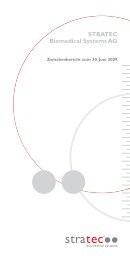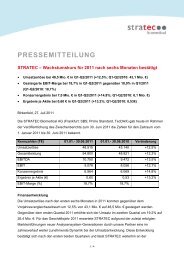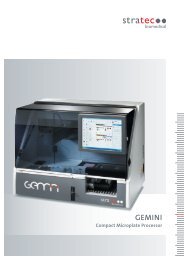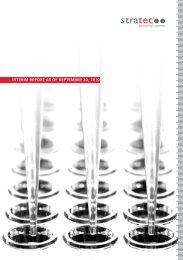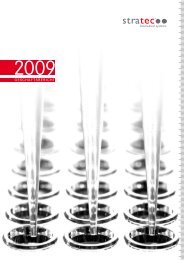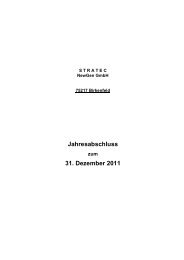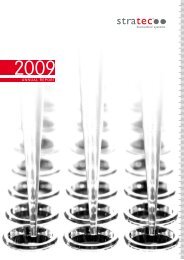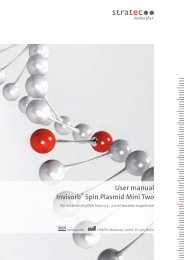PSP Spin Stool DNA Kit - STRATEC Biomedical AG
PSP Spin Stool DNA Kit - STRATEC Biomedical AG
PSP Spin Stool DNA Kit - STRATEC Biomedical AG
You also want an ePaper? Increase the reach of your titles
YUMPU automatically turns print PDFs into web optimized ePapers that Google loves.
ProcedureLysis<strong>Stool</strong> samples are lysed in Lysis Buffer P under denaturing conditions at high temperatures.Human cells lyse efficiently at RT, bacterial cells and those of other pathogens in the stoolsample are efficiently lysed by incubation at 95°C. This is recommended for detection of cellsthat are difficult to lyse (e.g. gram positive bacteria).Note: The total <strong>DNA</strong> concentration in the lysate will be increased 3-5 fold by lysis at 95°C and theratio of non human to human <strong>DNA</strong> will increase.Removal of PCR inhibitorsAfter lysis procedure <strong>DNA</strong> damaging substances and PCR inhibitors which are present in thefeces are adsorbed efficiently to the InviAdsorb matrix. InviAdsorb is provided veryconvenient in safe lock tubes and the lysate must only be mixed with the matrix. The boundcontaminations and cell debris are pelleted by centrifugation. The supernatant contains theprecleaned <strong>DNA</strong>.Protein digestionProteinase K is added to the supernatant to digest and degrade proteins during theincubation at 70°C.Binding of total <strong>DNA</strong>After adding Binding Buffer A to the supernatant, the mixture is transferred to the spincolumns and nucleic acids are bound to the membrane of the RTA <strong>Spin</strong> Filter during a briefcentrifugation step.Optimal salt concentrations and pH conditions in the lysate ensure that remains of digestedproteins and other contaminations, which can inhibit downstream enzymatic reactions, are notretained on the Invisorb membrane.Removing residual contaminants<strong>DNA</strong> bound to the Invisorb membrane is washed in three centrifugation steps. Contaminantsare efficiently and completely removed using Wash Buffer I and II, while the nucleic acidsremain bound to the membrane.ElutionThe nucleic acids are eluted in low salt buffer from the membrane using 100 - 200 µl ElutionBuffer. The eluted nucleic acids are ready to use in different subsequent tests.Yield and quality of total <strong>DNA</strong>The amount of purified <strong>DNA</strong> in the <strong>PSP</strong> ® <strong>Spin</strong> <strong>Stool</strong> <strong>DNA</strong> <strong>Kit</strong> procedure from feces, dependson the health status of the donor, bacteria content, sample source, transport, storage, andage. A typical yield is 10 – 80 µg, a typical <strong>DNA</strong> concentration is 50 – 300 ng/ µl. Yield andquality of isolated genomic <strong>DNA</strong> is suitable for any molecular-diagnostic detection system. Thediagnostic tests should be performed according to manufacturers’ specifications.<strong>PSP</strong> ® <strong>Spin</strong> <strong>Stool</strong> <strong>DNA</strong> <strong>Kit</strong> 0213<strong>PSP</strong> ® <strong>Spin</strong> <strong>Stool</strong> <strong>DNA</strong> Plus <strong>Kit</strong> 0213



